Yoshi Suhara
Celine
NVIDIA Nemotron Nano 2: An Accurate and Efficient Hybrid Mamba-Transformer Reasoning Model
Aug 21, 2025



Abstract:We introduce Nemotron-Nano-9B-v2, a hybrid Mamba-Transformer language model designed to increase throughput for reasoning workloads while achieving state-of-the-art accuracy compared to similarly-sized models. Nemotron-Nano-9B-v2 builds on the Nemotron-H architecture, in which the majority of the self-attention layers in the common Transformer architecture are replaced with Mamba-2 layers, to achieve improved inference speed when generating the long thinking traces needed for reasoning. We create Nemotron-Nano-9B-v2 by first pre-training a 12-billion-parameter model (Nemotron-Nano-12B-v2-Base) on 20 trillion tokens using an FP8 training recipe. After aligning Nemotron-Nano-12B-v2-Base, we employ the Minitron strategy to compress and distill the model with the goal of enabling inference on up to 128k tokens on a single NVIDIA A10G GPU (22GiB of memory, bfloat16 precision). Compared to existing similarly-sized models (e.g., Qwen3-8B), we show that Nemotron-Nano-9B-v2 achieves on-par or better accuracy on reasoning benchmarks while achieving up to 6x higher inference throughput in reasoning settings like 8k input and 16k output tokens. We are releasing Nemotron-Nano-9B-v2, Nemotron-Nano12B-v2-Base, and Nemotron-Nano-9B-v2-Base checkpoints along with the majority of our pre- and post-training datasets on Hugging Face.
Llama-Nemotron: Efficient Reasoning Models
May 02, 2025Abstract:We introduce the Llama-Nemotron series of models, an open family of heterogeneous reasoning models that deliver exceptional reasoning capabilities, inference efficiency, and an open license for enterprise use. The family comes in three sizes -- Nano (8B), Super (49B), and Ultra (253B) -- and performs competitively with state-of-the-art reasoning models such as DeepSeek-R1 while offering superior inference throughput and memory efficiency. In this report, we discuss the training procedure for these models, which entails using neural architecture search from Llama 3 models for accelerated inference, knowledge distillation, and continued pretraining, followed by a reasoning-focused post-training stage consisting of two main parts: supervised fine-tuning and large scale reinforcement learning. Llama-Nemotron models are the first open-source models to support a dynamic reasoning toggle, allowing users to switch between standard chat and reasoning modes during inference. To further support open research and facilitate model development, we provide the following resources: 1. We release the Llama-Nemotron reasoning models -- LN-Nano, LN-Super, and LN-Ultra -- under the commercially permissive NVIDIA Open Model License Agreement. 2. We release the complete post-training dataset: Llama-Nemotron-Post-Training-Dataset. 3. We also release our training codebases: NeMo, NeMo-Aligner, and Megatron-LM.
When2Call: When (not) to Call Tools
Apr 26, 2025Abstract:Leveraging external tools is a key feature for modern Language Models (LMs) to expand their capabilities and integrate them into existing systems. However, existing benchmarks primarily focus on the accuracy of tool calling -- whether the correct tool is called with the correct parameters -- and less on evaluating when LMs should (not) call tools. We develop a new benchmark, When2Call, which evaluates tool-calling decision-making: when to generate a tool call, when to ask follow-up questions and when to admit the question can't be answered with the tools provided. We find that state-of-the-art tool-calling LMs show significant room for improvement on When2Call, indicating the importance of this benchmark. We also develop a training set for When2Call and leverage the multiple-choice nature of the benchmark to develop a preference optimization training regime, which shows considerably more improvement than traditional fine-tuning. We release the benchmark and training data as well as evaluation scripts at https://github.com/NVIDIA/When2Call.
CLIMB: CLustering-based Iterative Data Mixture Bootstrapping for Language Model Pre-training
Apr 17, 2025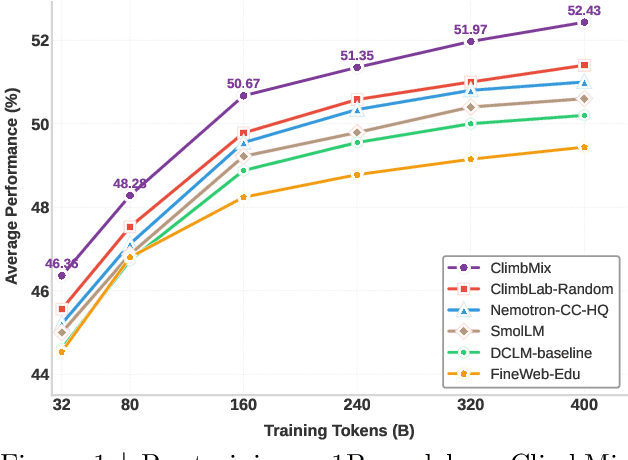

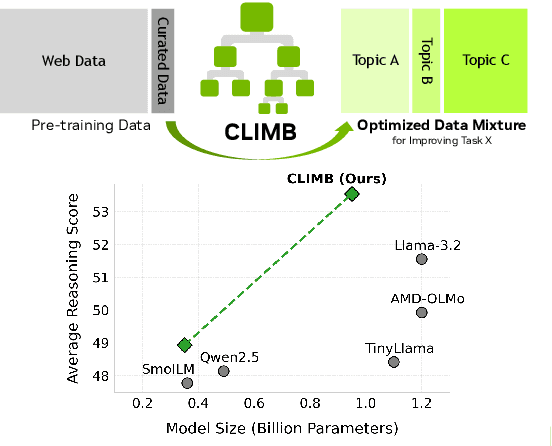
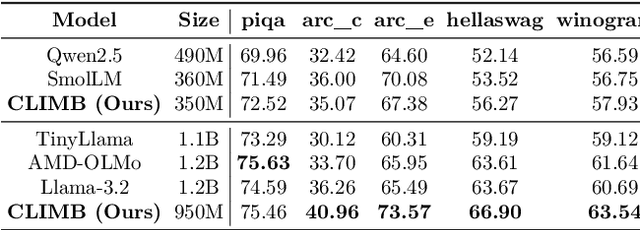
Abstract:Pre-training datasets are typically collected from web content and lack inherent domain divisions. For instance, widely used datasets like Common Crawl do not include explicit domain labels, while manually curating labeled datasets such as The Pile is labor-intensive. Consequently, identifying an optimal pre-training data mixture remains a challenging problem, despite its significant benefits for pre-training performance. To address these challenges, we propose CLustering-based Iterative Data Mixture Bootstrapping (CLIMB), an automated framework that discovers, evaluates, and refines data mixtures in a pre-training setting. Specifically, CLIMB embeds and clusters large-scale datasets in a semantic space and then iteratively searches for optimal mixtures using a smaller proxy model and a predictor. When continuously trained on 400B tokens with this mixture, our 1B model exceeds the state-of-the-art Llama-3.2-1B by 2.0%. Moreover, we observe that optimizing for a specific domain (e.g., Social Sciences) yields a 5% improvement over random sampling. Finally, we introduce ClimbLab, a filtered 1.2-trillion-token corpus with 20 clusters as a research playground, and ClimbMix, a compact yet powerful 400-billion-token dataset designed for efficient pre-training that delivers superior performance under an equal token budget. We analyze the final data mixture, elucidating the characteristics of an optimal data mixture. Our data is available at: https://research.nvidia.com/labs/lpr/climb/
Efficient Hybrid Language Model Compression through Group-Aware SSM Pruning
Apr 15, 2025Abstract:Hybrid LLM architectures that combine Attention and State Space Models (SSMs) achieve state-of-the-art accuracy and runtime performance. Recent work has demonstrated that applying compression and distillation to Attention-only models yields smaller, more accurate models at a fraction of the training cost. In this work, we explore the effectiveness of compressing Hybrid architectures. We introduce a novel group-aware pruning strategy that preserves the structural integrity of SSM blocks and their sequence modeling capabilities. Furthermore, we demonstrate the necessity of such SSM pruning to achieve improved accuracy and inference speed compared to traditional approaches. Our compression recipe combines SSM, FFN, embedding dimension, and layer pruning, followed by knowledge distillation-based retraining, similar to the MINITRON technique. Using this approach, we compress the Nemotron-H 8B Hybrid model down to 4B parameters with up to 40x fewer training tokens. The resulting model surpasses the accuracy of similarly-sized models while achieving 2x faster inference, significantly advancing the Pareto frontier.
Nemotron-H: A Family of Accurate and Efficient Hybrid Mamba-Transformer Models
Apr 10, 2025

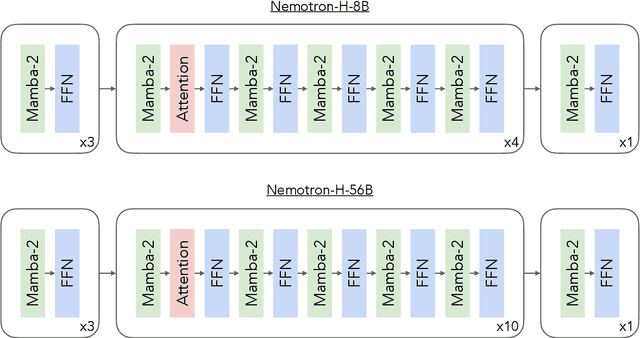
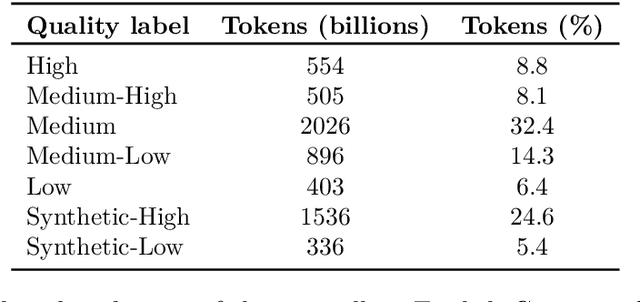
Abstract:As inference-time scaling becomes critical for enhanced reasoning capabilities, it is increasingly becoming important to build models that are efficient to infer. We introduce Nemotron-H, a family of 8B and 56B/47B hybrid Mamba-Transformer models designed to reduce inference cost for a given accuracy level. To achieve this goal, we replace the majority of self-attention layers in the common Transformer model architecture with Mamba layers that perform constant computation and require constant memory per generated token. We show that Nemotron-H models offer either better or on-par accuracy compared to other similarly-sized state-of-the-art open-sourced Transformer models (e.g., Qwen-2.5-7B/72B and Llama-3.1-8B/70B), while being up to 3$\times$ faster at inference. To further increase inference speed and reduce the memory required at inference time, we created Nemotron-H-47B-Base from the 56B model using a new compression via pruning and distillation technique called MiniPuzzle. Nemotron-H-47B-Base achieves similar accuracy to the 56B model, but is 20% faster to infer. In addition, we introduce an FP8-based training recipe and show that it can achieve on par results with BF16-based training. This recipe is used to train the 56B model. All Nemotron-H models will be released, with support in Hugging Face, NeMo, and Megatron-LM.
Hymba: A Hybrid-head Architecture for Small Language Models
Nov 20, 2024



Abstract:We propose Hymba, a family of small language models featuring a hybrid-head parallel architecture that integrates transformer attention mechanisms with state space models (SSMs) for enhanced efficiency. Attention heads provide high-resolution recall, while SSM heads enable efficient context summarization. Additionally, we introduce learnable meta tokens that are prepended to prompts, storing critical information and alleviating the "forced-to-attend" burden associated with attention mechanisms. This model is further optimized by incorporating cross-layer key-value (KV) sharing and partial sliding window attention, resulting in a compact cache size. During development, we conducted a controlled study comparing various architectures under identical settings and observed significant advantages of our proposed architecture. Notably, Hymba achieves state-of-the-art results for small LMs: Our Hymba-1.5B-Base model surpasses all sub-2B public models in performance and even outperforms Llama-3.2-3B with 1.32% higher average accuracy, an 11.67x cache size reduction, and 3.49x throughput.
Your Large Language Models Are Leaving Fingerprints
May 22, 2024Abstract:It has been shown that finetuned transformers and other supervised detectors effectively distinguish between human and machine-generated text in some situations arXiv:2305.13242, but we find that even simple classifiers on top of n-gram and part-of-speech features can achieve very robust performance on both in- and out-of-domain data. To understand how this is possible, we analyze machine-generated output text in five datasets, finding that LLMs possess unique fingerprints that manifest as slight differences in the frequency of certain lexical and morphosyntactic features. We show how to visualize such fingerprints, describe how they can be used to detect machine-generated text and find that they are even robust across textual domains. We find that fingerprints are often persistent across models in the same model family (e.g. llama-13b vs. llama-65b) and that models fine-tuned for chat are easier to detect than standard language models, indicating that LLM fingerprints may be directly induced by the training data.
Large Language Models are Inconsistent and Biased Evaluators
May 02, 2024Abstract:The zero-shot capability of Large Language Models (LLMs) has enabled highly flexible, reference-free metrics for various tasks, making LLM evaluators common tools in NLP. However, the robustness of these LLM evaluators remains relatively understudied; existing work mainly pursued optimal performance in terms of correlating LLM scores with human expert scores. In this paper, we conduct a series of analyses using the SummEval dataset and confirm that LLMs are biased evaluators as they: (1) exhibit familiarity bias-a preference for text with lower perplexity, (2) show skewed and biased distributions of ratings, and (3) experience anchoring effects for multi-attribute judgments. We also found that LLMs are inconsistent evaluators, showing low "inter-sample" agreement and sensitivity to prompt differences that are insignificant to human understanding of text quality. Furthermore, we share recipes for configuring LLM evaluators to mitigate these limitations. Experimental results on the RoSE dataset demonstrate improvements over the state-of-the-art LLM evaluators.
Source Identification in Abstractive Summarization
Feb 07, 2024Abstract:Neural abstractive summarization models make summaries in an end-to-end manner, and little is known about how the source information is actually converted into summaries. In this paper, we define input sentences that contain essential information in the generated summary as $\textit{source sentences}$ and study how abstractive summaries are made by analyzing the source sentences. To this end, we annotate source sentences for reference summaries and system summaries generated by PEGASUS on document-summary pairs sampled from the CNN/DailyMail and XSum datasets. We also formulate automatic source sentence detection and compare multiple methods to establish a strong baseline for the task. Experimental results show that the perplexity-based method performs well in highly abstractive settings, while similarity-based methods perform robustly in relatively extractive settings. Our code and data are available at https://github.com/suhara/sourcesum.
 Add to Chrome
Add to Chrome Add to Firefox
Add to Firefox Add to Edge
Add to Edge